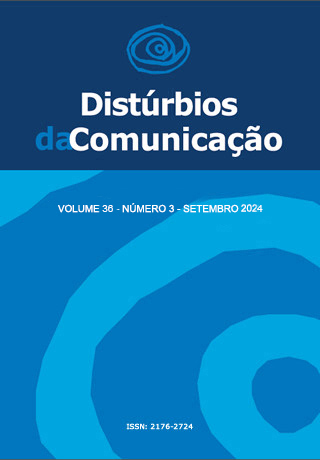Quantitative, qualitative, and mixed methodological approaches in oral language research published in brazilian speech-language pathology journals
DOI:
https://doi.org/10.23925/2176-2724.2024v36i3e67351Keywords:
Qualitative Analysis, Quantitative Analysis, Language, Data Interpretation, StatisticalAbstract
Introduction: The theme of quantitative, qualitative, and mixed methodological approaches in Oral Language research is essential for understanding the context in which these studies are conducted concerning the production of scientific knowledge in the field of Speech-Language Pathology, based on the assumption that Oral Language is a phenomenon of vast biopsychosocial complexity. Objective: To investigate the occurrences of qualitative, quantitative, or mixed methodological approaches in Oral Language research published in Brazilian Speech-Language Pathology journals. Method: Sample: Publications in the journals Audiology Communication Research (ACR), CEFAC Magazine, Communication Disorders and Sciences (CoDAS), and Distúrbios da Comunicação Magazine (DIC) between January 2020 and March 2024. Procedure: Reading of titles and abstracts. After data collection, the authors acted as judges to compile the database; the data were transferred to a Microsoft Excel® spreadsheet with the variables: title; authors; publication date; journal and methodological approaches. Results and discussion: N=129 publications; ACR: N=24; 6 (25%) quantitative, 15 (62.5%) qualitative, and 3 (12.5%) mixed. CEFAC: N=27; 15 (55.56%) quantitative; 10 (37.04%) qualitative; 2 (7.40%) mixed. CODAS: N=48; 34 (70.83%) quantitative; 4 (8.34%) qualitative; 10 (20.83%) mixed. DIC: N=30; 9 quantitative publications (30%), 16 qualitative (53.33%), 5 (16.67%) mixed. Quantitative research predominated in CEFAC and CODAS journals. In the ACR and DIC journals, qualitative studies predominated. Studies with a mixed approach appear with less representation in the analyzed period. Conclusion: The study points to significant methodological diversity, with variations in the proportions of quantitative, qualitative, and mixed studies, with a predominance of the quantitative approach.
Downloads
References
Creswell JW. Mapping the developing landscape of mixed methods research. Journal of Mixed Methods Research. 2010; 4(3): 317-31.
Patton MQ. Enhancing the quality and credibility of qualitative analysis. Health Services Research. 1999; 34(5 Pt 2): 1189-208.
Guba EG, Lincoln YS. Paradigmatic controversies, contradictions, and emerging confluences. The Sage Handbook of Qualitative Research. 2005; 3:191-215.
Bryman A. Integrating quantitative and qualitative research: how is it done? Qualitative Research. 2006; 6(1): 97-113
Turato ER. Tratado da metodologia da pesquisa clínico-qualitativa: construção teórico-epistemológica, discussão comparada e aplicação nas áreas da saúde e humanas. 3ª ed. Petrópolis: Vozes; 2003.
Turato ER. Métodos qualitativos e quantitativos na área da saúde: definições, diferenças e seus objetos de pesquisa. Rev Saúde Pública. 2005; 39(3): 507-14.
Minayo MCS. Qualitative analysis: theory, steps and reliability. Ciência & Saúde Coletiva. 2012;17(3): 621-26.
Johnson RB, Onwuegbuzie AJ. Mixed methods research: A research paradigm whose time has come. Educ Res. 2004; (7): 14-26.
Tashakkori A, Teddlie C. Major issues and controversies in the use of mixed methods in the social and behavioral sciences. Handbook of Mixed Methods in Social & Behavioral Research. 2003; 3-50.
Denzin NK. Triangulation in educational research. Educational Researcher. 1970; 2(7): 7-11.
Creswell JW, Plano Clark VL. Designing and conducting mixed methods research. Thousand Oaks: Sage Publications. 2007; 2(3): 58-88.
Azoni CAS, Lamônica DAC. Communication disorders in children: the importance of early diagnosis. Revista CEFAC. 2012; 14(4): 789-95.
Guest G, Bunce A, Johnson L. How many interviews are enough? An experiment with data saturation and variability. Field Methods. 2006;18(1): 59-82.
Sandelowski M. Combining qualitative and quantitative sampling, data collection, and analysis techniques in mixed-method studies. Res Nurs Health. 2000; 23(3): 246-55.
Yin RK. Validity and generalization in future case study evaluations. Evaluation. 2013; 19(3): 321-32.
Morse JM. Approaches to qualitative-quantitative methodological triangulation. Nurs Res. 1991; 40(2): 120-3.
Downloads
Published
Issue
Section
License
Copyright (c) 2024 Mara Lucia Pallotta, Letícia Batista Gouveia, Maria Claudia Cunha

This work is licensed under a Creative Commons Attribution 4.0 International License.









